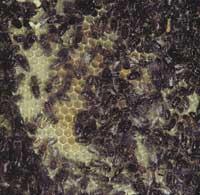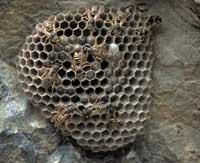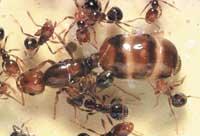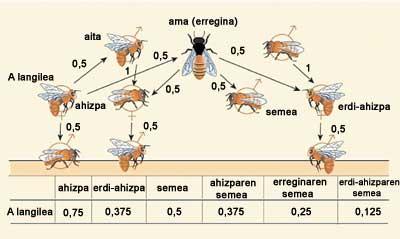'Police State'
Apparently, hives and concrete mixers seem to be model societies and each specimen works enthusiastically for the benefit of the whole group.
Workers in bee, ant or wasp colonies do not reproduce, thus increasing the reproductive success of their queen. In the common bee the workers have an enormous ‘devotion’ to the group: they do not reproduce and, moreover, any animal that attacks the hive is chopped and then slaughtered. Especially the latter has always fascinated nature lovers.

Now we know that this ‘evolutionary tax’ of worker bees is a consequence of their kinship with the queen. Being sisters of the queen, they have many genes equal to the descendants of the queen. Therefore, taking care of the queen's positions, they take care of her genetic heritage.
But in all societies it can happen that someone breaks the rules and finds the way forward. Workers also lay their eggs from time to time. But this, in addition to attacking the interests of the queen, places them against the other worker bees. And that generates a certain need for controllers. In the late 1980s, the evolving expert, Francis Ratnieks, observed the existence of worker bees carrying out control tasks: they eat offender eggs and thwart their reproductive attempt.
This control over egg intake is not common throughout the genus Apis. However, bees are not the only ones: recently the same behavior has been observed in some wasp species and in a group of ants.
But sometimes the control fails. Sometimes anarchy prevails in hives, beginning to proliferate workers. For example, a common bee subspecies is causing damage to hives in South Africa, as this control system is avoided and the number of workers increases. Evolutionary biologists hope that by studying competing behaviors of authoritarianism and anarchy, they will better understand the balance between cooperativism and selfishness at all levels, from genomic genes to human beings in society.
Family relationships
In the hymenoptera society is very developed. And this, probably, is related to how to determine the sex of the descendants, haplodiploidism. In fact, in the hymenoptera sexual reproduction always produces posterior females and diploids (that is, they have two chromosomal groups as humans). However, male hymenoptera are born from unfertilized eggs and have a single group of chromosomes and all equal. The sperm produced by these haploid males is genetically identical, unlike the diploid animals.

In human families, siblings have half the genes, that is, kinship ( r) is 0.5, insofar as they are descendants of the same parents. The same goes for parents and descendants. In siblings who have only one parent is r = 0.25.
But haplodiplocond reproduction produces curious family dynamics (see diagram). The kinship of the mother with her child is 0.5, but if we look at the same bond from the point of view of the child, r = 1.0. The relationship between brothers is not the same: from the point of view of his sister r = 0.25; his brother is 0.5. Mothers and daughters have a 0.5 kinship anywhere and the r between sisters is always 0.75.
These last two cases are of great importance, as they mean that a female can take care of her genetic interests more effectively than with the growth of her daughters (sisters). This helps explain why most female social hymenopterans do not reproduce. If the queen is the mother of the other working females, they have little to gain if they create their daughters.
However, in the common bee, for example, the queen copulates with more than 20 males of her century. Therefore, the workers take care of semi-sister offspring (not whole) with a kinship of 0.375 and not 0.75. And they accept it.
On the contrary, descendants who had a kinship of 0.5 for workers (males, because they were created without copulation) do not accept them; they eat them. In fact, for most workers, the descendants of another worker are half grandchildren, only 0.125 of kinship. In this case, the controllers will do their job.
May God save the queen
At the top end of the control system is the queen, who secretes hormones to induce workers to act in control. Most have the ovaries paralyzed and act faithful against the rebels.
But even if they were not, it can be said that the work of the controller staff is remarkable for the scarcity of ‘offenders’. Of the 30,000 hive workers, about 3 have functional ovaries. The imbalance is evident. Although these females spawn around 7% of the hive eggs, the effectiveness of the controllers makes only a thousand males have as working mother.

In most cases, workers' eggs are eaten within hours of laying, as they do not have the chemical protection that only the queen's eggs have. In addition, it seems that hive workers are able to figure out when another is about to break the rules, as they act aggressively with active ovaries. But, as in dictatorial societies, the death of the leader can cause major changes in society. After the death of the queen and the disappearance of her hive hormones, the workers begin to put it.
Hives are the most developed controlling societies found in insects. Wasp societies are smaller and simpler, but they also have a good example of behavior consistent with evolutionary theory. For example, in some species of wasps, the queen copulates with a single male and sometimes with several males. When queens are monogamous and therefore all workers are sisters, the kinship between the offspring of one worker and another worker is 0.375. However, for queens that copulate several times it is 0.125. In both cases, the relationship between the workers and the descendants of the queen is 0.25.
In view of this, workers should accept the positions of each other if the female copulates only once (0.375 over 0.25), but they would destroy them if the queen coulla more times. And that is what happens: in the Saxonese wasp ( Dolichovespula saxonica) the control changes. The queen copulates only once or with several males, but the controllers are only found in the colonies of females that copulate several times.
Fascist Regime

In some species of ants of the genus Ponera, the social structure and the control system are less sophisticated. They inhabit tropical forests in colonies of 100 or less specimens, without a strict separation between queen and workers. On the contrary, all females have possibilities of sexual reproduction. But in reality they reproduce one or a few, since the small colonies cannot bear the presence of many reproducers.
The females who breed are at the head of a hierarchical organization, at the base are the oldest workers and at the center the youngest. This hierarchy is reinforced by overflowing and harsh methods of repression. For example, if a young worker tries to reproduce, the rest of his peers are caught in hours and days. Next, it is the progressive reduction and loss of reproductive capacity expected by this ant. But they often cut or even kill some part of the body.
But pregnant females of the genus Ponera do not control their control system as drastically as nuns. From time to time the controlling ants rebel, they abandon decaying authority to help a young man.
Also in common bees, workers can overcome the reproductive monopoly of the queen by activating their ovaries and accepting each other eggs. But this type of anarchic hives are very scarce. According to the researchers, this fact is due to the need for two mutations: on the one hand, the pheromone that inhibits the ovaries of workers, and on the other, the laying of eggs that avoid the control system, probably falsifying the chemical signal of the queen. The different genetic control of both events makes it difficult for simultaneous mutations to occur.
Educational anarchy

However, although in the wild it seems that some anarchic beehives advance, in them there are also few dozens of workers speakers. Taking advantage of selective growth, the number of speakers has increased to 40% of total workers in some studies. In this type of hives, the breeding staff does not meet their obligations and begins to deteriorate the hive until its total collapse.
But they also have more extraordinary features. For example, normal workers transferred to these hives may start spawning, suggesting that the queen's pheromones are weaker than normal. Or, more rarely, the departure of the queen from an anarchic colony (which would cause the workers to start the laying on conventional hives) causes the eggs of the anarchic workers to lose the false chemical signal. They are fed if introduced into a conventional hive.
Researchers try to identify genes that affect anarchic behavior, believing that their discovery could identify mechanisms for theories of conflict and cooperation between animals.







